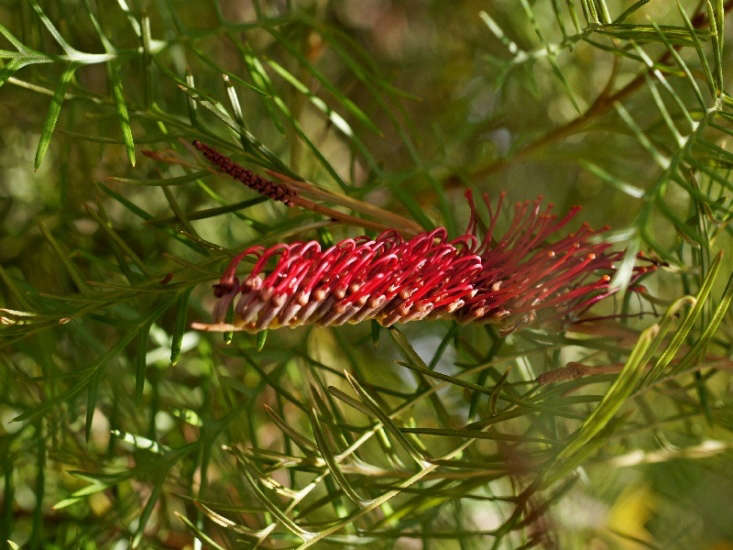Spider Flower, Grevillea: “Curly Ribbon”
I’m a flower girl. And the more exotic, twisted and remarkable the flowers, the more I am enthralled. So when I was introduced to the shrub Grevillea and saw flowers that looked like someone took a scissors’ edge to ribbon and curled it crazy, I was sold. Then, upon learning that these evergreen beauties were deer- and drought-resistant, I swore to use them whenever and wherever my clients’ garden designs allowed.
Please keep reading to learn more about grevilleas.

Grevilleas are truly a diverse and gigantic genus, from ground covers to trees; 360 species of these evergreen flowering plants are in the protea family. Native to open lands in Australia mainly, a land that is massive and environmentally diverse, grevilleas have evolved to adapt to a wide range of conditions, from desert to high mountain zones. And most grevilleas are woody shrubs with fine needles or intricately dissected sturdy leaves (not soft and tender little perennials), likely an adaptation to drought and unkind soil. But what I love about grevilleas (other than the colorful, spidery, curly flowers) is that they are resilient, low maintenance, and tough. They epitomize fancy and care free.

Hardiness to cold is the main factor to consider when choosing grevilleas. Most are hardy down to 20 degrees Fahrenheit. The varieties that grow in Australia’s higher and colder elevations withstand a better chance in vulnerable gardens, but we are not talking about arctic air or snow. We are talking about gardens that dip into the teens. One tough variety is Grevillea junipero ‘Molonglo’, which is hardy in zones 8a to 10b. ‘Molonglo’ is a 2-foot-high spreading cultivar with needle-like leaves and a profusion of curious apricot colored flowers.

My favorites include Grevillea ‘Red Hooks’, a robust 7-foot-tall shrub with reaching branches and deeply cut leaves. It has vibrant red toothbrush flower heads that bloom from August to January, and is very popular and ornamental for informal hedging. This shrub appreciates pruning and grows best in sun or light shade and can withstand temperatures in the mid 20s (Fahrenheit).
I also love Grevillea ‘Wakiti Sunrise’. It’s a mounding 3-foot-high by 8-foot-wide ground cover with distinct gray-green leaves. The attractive orange flowers show off fall through spring during winter’s doldrums.
Cheat Sheet
- Most varieties of Grevillea have a generous season of bloom, and the exotic, nectar-rich flowers are highly irresistible to hummingbirds, birds, and exotic gardeners alike.
- Plant taller varieties solo as a specimen or group them if using the ground cover types.
- Combine grevillea with other drought-tolerant, deer-resistant, and fuss-free plants, such as leucadendrons, leucospermums, and rosemary.
Keep It Alive

- Most grevilleas appreciate sunny, dry locations.
- Grevillea thrives on well-draining soil that is low in organic matter; soil that is too rich or has high levels of phosphorus can be toxic and fatal. Tip: Easier to just avoid all fertilizers.
- Prune grevilleas after flowering for shape and flower rejuvenation.
See more growing tips in Grevilleas: A Field Guide to Planting, Care & Design in our curated guides to Shrubs 101. Read about more of our favorite evergreen shrubs:
- Shrubs: A Guide to Growing, Care, and Design
- Yews 101: A Field Guide
- Arborvitae: A Field Guide to Planting, Care & Design












Have a Question or Comment About This Post?
Join the conversation (3)